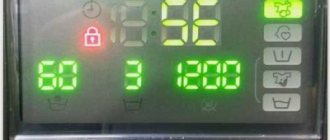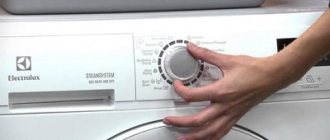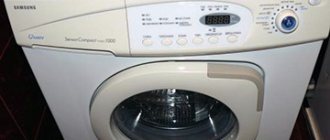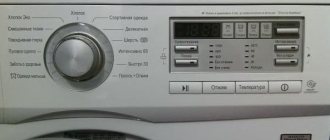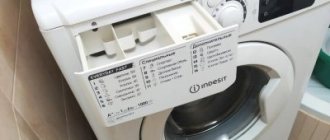Any equipment fails sooner or later. Washing machines in the budget category, for example, Indesit brand models such as WISL 82, WISL 83, WISL 102, WISL 103, WISL 105, IWSC 5105 (especially those that have been in use for a long time), often require repairs. Failures can be very different, and in order to correctly determine the cause of the malfunction and eliminate it, as a rule, the machine needs to be disassembled.
To determine the cause of the malfunction and eliminate it, it is usually necessary to disassemble the washing machine
Sometimes it is enough to simply remove one of the housing covers, but there are times when you need to get to a bearing located in the drum or to another hard-to-reach part. Then the owners of the equipment are faced with a serious task, the solution of which must be approached with full responsibility.
If you want to save money, try performing repairs without contacting a service center. In our article we will tell you how to disassemble an Indesit washing machine with your own hands so that you can easily reassemble it later.
Preparation
Before you begin any repairs, you need to make sure you have the necessary tools. You may need:
- a set of flat and Phillips screwdrivers;
- socket and open-end wrenches;
- set of heads and knobs;
- hammer;
- multimeter;
- bit;
- hacksaw for metal;
- pliers;
- WD-40 product;
- awl.
To disassemble a washing machine, you may need a variety of tools.
Please note that the presented list of tools and tools is as wide as possible and allows you to perform any repair. In some cases, you can get by with a much smaller set.
You must understand that troubleshooting can take more than one day, and the removed parts will take up a lot of space. Therefore, if possible, move the unit to a garage, shed or any other utility room, where it will not be in the way, and spare parts can be neatly laid out.
Before disassembling the automatic machine, find the warranty card and make sure that the warranty period has expired. Remember that the manufacturer is not responsible for equipment that was repaired at home, so if the warranty is still in force, contact a specialized service center.
If there is no free space, organize the work on site: prepare a section of the floor at least 2 x 2 m in size, removing carpets, furniture and covering it with film or old newspapers. Disconnect the washing machine from all communications and carefully disconnect the hoses.
It is imperative to drain the remaining water from the tank so that during disassembly it does not get on other parts. To do this, place a dry cloth under the machine, unscrew the drain filter and wait until all the water drains from the hole. Also remove the detergent tray (usually to do this you need to press the latch located in the middle and at the same time pull the part towards you) and set it and the filter aside.
In order to disassemble a washing machine, certain skills are required. If you are not confident in your own abilities, it is better to entrust the work to professionals.
So, the Indesit washing machine is ready for disassembly, what should you do first?
Preparatory work
The procedure for carrying out the work process for disassembling washing machines of any Lg, Samsung models directly depends on the type of laundry loading - frontal or vertical type. Sometimes it is enough to simply remove the rear panel of the car, as a result, this will provide access to components that in most cases fail. For example, heating elements or various drum elements with a high risk of wear. Many experts recommend that before you start disassembling Samsung or Indesit washing machines, you should still familiarize yourself with the electrical circuit and the design of these devices. And regardless of the type of this device - automatic, semi-automatic, small and models (Samsung, Zanussi. Indesit), the device has similarities. After this, you can begin to disassemble and repair this device yourself.
Before you start disassembling the washing machine, you need to do the following:
- first of all, you need to carefully read the instructions and study its rules;
- Next, you should select and prepare the necessary equipment for the work;
- it is necessary to disconnect the machine from the power supply and water supply system, and you also need to disconnect the drain hose from the outlet to the sewer.
Then we prepare the necessary tools and equipment to disassemble the washing machine:
- service type hook;
- wrenches 8, 9 and 19;
- flat screwdriver;
- a screwdriver with a cross-shaped end;
- pliers, wire cutters that will be used for self-clamping clamps;
- ordinary wire cutters;
- insulated pliers;
- long bent pliers.
Tools
When disassembling the washing machine, keep in mind that most of the parts and elements of the washing device are made of plastic material, so disassemble these parts with extreme caution and very carefully so as not to cause harm or break these elements.
How to remove main parts
The washing machine consists of many parts, most of which are hidden inside the body.
Here is a schematic representation of the main parts of the washing machine
We begin to disassemble the case from the top panel , which is secured with two bolts located on the back side of the machine; they need to be unscrewed first. Then, standing at the front of the unit, pull the panel towards you and lift it slightly.
Next we move on to the rear panel , which is held on by six self-tapping screws. You can unscrew them using a screwdriver. Directly behind the cover you will see the drive belt; it is better to immediately remove it too, carefully turning the pulley wheel clockwise.
The diagram shows in which direction you need to rotate the pulley to remove the belt from it
To dismantle the dashboard , unscrew several screws located in the niche of the detergent tray. Then we disconnect the wires and the pipe, remove the panel from the latches and put it aside.
During the disassembly process, the location of the parts and the connection diagram of the contacts can be photographed so that after the repair you can quickly and correctly reassemble in the reverse order.
At the top of the washing machine there are: a counterweight (stone), a pipe connecting the powder compartment to the tank, a water intake valve and its contacts, as well as a pressure switch, its tube and contacts. We remove all these details.
Before removing the front panel , remove the hatch door and rubber seal. We begin dismantling with the cuff - bend it with a screwdriver and carefully remove it. We dismantle the door by unscrewing several bolts that hold the hinge. Then we remove the screws that hold the front panel in place and move it to the side.
Remove the rubber cuff by carefully bending it using a screwdriver
In the lower part of the unit, it is necessary to dismantle the electric motor, tubular electric heater (TEH), lower counterweight, drain pipe and shock absorbers on which the tank is supported.
The heating element is easy to find by the end, which is visible under the tank. Remove all wiring from the heater contacts. Unscrew the nut located in the center between the contacts. Having loosened the element, remove it from the groove. We remove the power supply and ground wire from the engine, and then unscrew the bolts securing it.
The heating element is located under the tank, to remove it you need to disconnect the contacts and unscrew the nut located in the center
To remove the shock absorbers and drain pipe, you need to place the washing machine on its side. Using pliers, remove the clamp and disconnect the drain pipe from the pump. Then unscrew the shock absorbers.
To dismantle the drain pipe, you need to loosen and remove the clamps holding it
After dismantling all the parts, remove the tank. But what if this is not enough? How to disassemble the drum of an Indesit washing machine located inside a non-separable tank?
Tools
First of all, it is necessary to provide sufficient space and good lighting. You won't be able to disassemble the car without tools. It should be noted that manufacturers use different solutions in manufacturing.
Therefore, let's consider a universal set. It will allow you to disassemble any car. List:
- Socket wrench with ratchet. Size - 10 and 13.
- Screwdrivers - T10, T15, T20, RN1, RN2, slotted SL 2-20.
- Set of socket heads with ratchet - from 5.5 to 13.
- Flashlight.
- Pliers.
- Round nose pliers.
- Wire cutters.
How to disassemble the tank and drum
Washing machines of the Indesit brand usually have non-separable tanks, that is, if any element located inside fails, the manufacturer recommends replacing the entire part. Such repairs can be expensive, so if it is necessary to replace, for example, a bearing, it is still better to disassemble the tank.
In the photo you see a non-separable washing machine tank in which the drum is located
Dismantling begins by removing the pulley (the wheel through which the belt passed). The bolt that secures this part is subject to significant stress, and it is important that it holds tightly. Therefore, when assembling a machine, it is often not just screwed on, but also additionally secured with glue. It is better to use a T40 hexagonal star wrench and loosen the bolt, gradually loosening it. If the part does not give in, spray it with WD-40 or carefully knock it off the glue with a hammer.
In order to unscrew the bolt securing the pulley, you need to use a T40 hexagonal star wrench.
Next, we lay the tank on its side and carefully cut it with a hacksaw along the seam (where the two halves of the part are soldered). First, use a drill to drill holes around the entire perimeter of the seam (during assembly, the halves can be easily fastened with bolts).
When the tank is open, unscrew the bolts securing the drum, unfasten the fastenings and remove the tank wall. Now you can disassemble the drum, that is, remove the oil seal and bearings from it.
We start with the bearing located closer to the outside of the drum. We lay the part with the hatch hole down, place the chisel on the outer rim of the metal ring and hit it with a hammer.
You will need a hammer and chisel to remove the bearing from the drum.
We carefully monitor the position of the chisel when knocking out the bearing - if the tool slips and the inner ring is struck, it may fly out, and it will be quite difficult to remove the remaining bearing from the seat. We dismantle the inner bearing in the same way, and then remove the oil seal.
Disassembling the drum of the Indesit washing machine (video)
To prevent tank repair from being a constant ritual, you need to ensure that unnecessary objects get into the space of the tank and drum. But if damage could not be avoided and repair or replacement is now necessary, you need to contact a specialist. It is a qualified worker who will be able to select the necessary parts for the machine and install them without worrying about the remaining bolts. Until the technician arrives, you need to stop using the washing machine in order to ensure the safety of repairing your own apartment and the apartments of your neighbors.
Attention, TODAY only!
A washing machine, like any other type of equipment, is subject to wear and tear. Of course, we really hope that breakdowns will bypass your equipment, but if this does happen, then diagnostics and repairs are inevitable. And in order to diagnose some failures of the washing machine, it is necessary to remove the top cover of the washing machine. Most often, repairs begin with this procedure, so almost every owner of a washing machine may be faced with a situation where he will need this knowledge. For example, when the handle on the washing machine door breaks and you need to get to the lock through the top of the machine.
Here we will tell you step by step and explain how to remove the top cover of washing machines LG, Electrolux, Zanussi, Candy, Ariston, Indesit, Samsung, Ardo, as well as older Bosh and Siemens models.
Before starting repairs, be sure to turn off the power to the washing machine.
Features of disassembling units with vertical loading
How to disassemble an Indesit top-loading washing machine? The procedure will not differ much from that described above, because the device contains the same elements as a front-loading washing machine (pressure switch, water intake valve, drum, tank, control board, pump, etc.). The main differences are that the axis of the “vertical” drum is structurally made on two bearings, and sometimes a self-positioning sensor is located on the tank (fixing the drum with the flaps up).
In the photo you can see the structure of a top-loading washing machine
We begin to disassemble the unit from the control panel by unscrewing the screws holding it on the sides or simply prying the part with a screwdriver and sliding it towards you, not forgetting to disconnect the contacts. Under the panel there is a control board, which we also dismantle.
Then remove the top cover (its fastenings are usually located under the control board) and side panels, carefully disconnect the clamp from the drum.
Further actions will consist of sequential removal of all parts. The bearings in a top-loading washing machine are located on both sides of the drum, so removing them will take a little longer.
We will be glad if our article helps you repair your washing machine yourself. Follow the instruction manual, take your time, be careful, and you will succeed!
Other options
Some machines, such as Ardo models, require the cover to be removed a little differently.
After unscrewing the screws at the back of the device, the cover should move not to the back, but forward (towards you if you are facing the hatch). In this case, the lid will shift only at a certain angle, which you will have to determine.
You may also come across the option of mounting the top cover not on the back, but on the front wall. For example, such a mount can be found in older devices from Siemens and Bosch.
After removing the plugs, unscrew the screws, then slightly lift the cover up and move it to the front in relation to the machine. As with the Ardo machines, you will need to find an angle at which the lid can be easily removed.
Typical breakdowns
Vertical washing machines from Indesit have particularly “sore” spots, which most often lead to machine failure. They are called typical problems, and experienced technicians have long been accustomed to such complaints from machine owners. As a rule, people contact the service center for the following reasons.
- The drum doors open directly during washing, which leads to damage to the heating element and depressurization of the tank.
- Poor quality metal casing is quickly damaged by corrosion, which makes the machine unsightly.
- The laundry loaded into the drum is unevenly distributed along the walls, and an imbalance occurs.
- The electronics turn out to be weak, the software is often reset, and resistors on the control board burn out.
- Bearings quickly become deformed and destroyed.
Repairs do not always require disassembling the machine. But it is better to know all the instructions so that you are prepared and aware.


